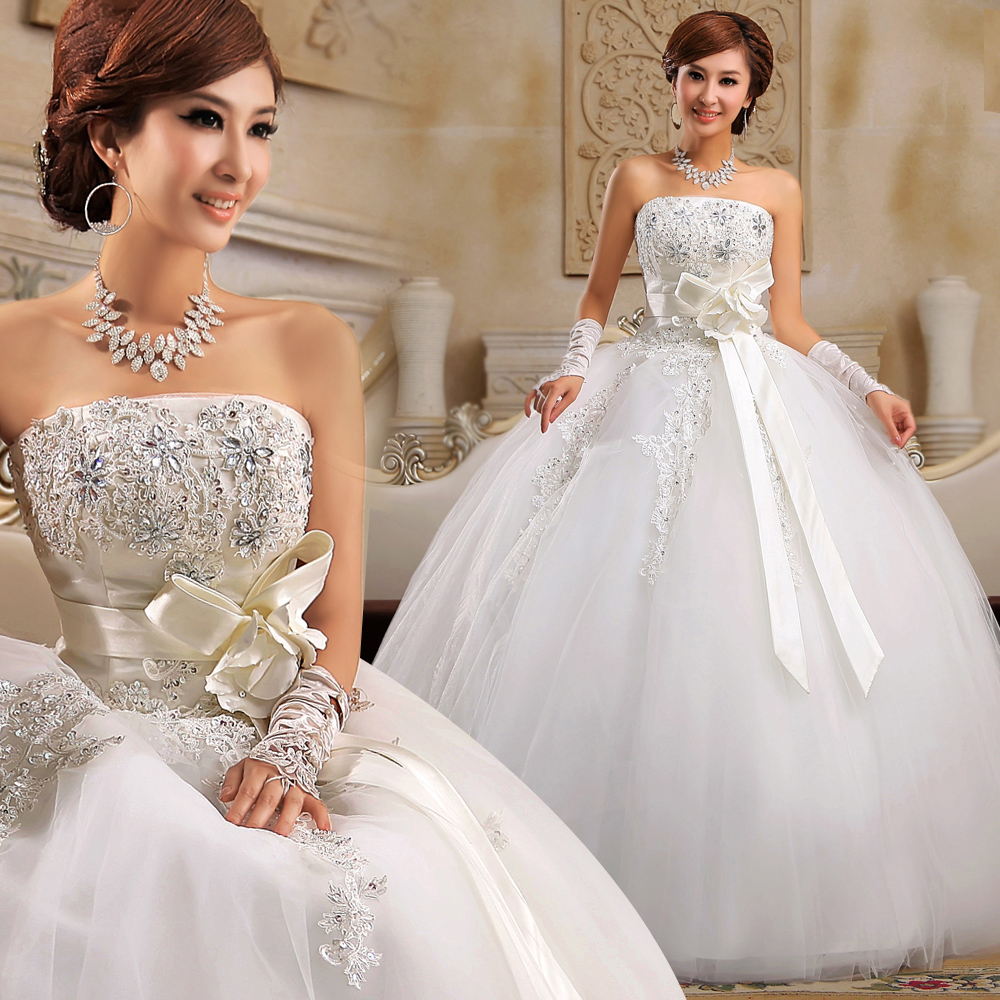Wedding Dress Definition
Source(Google.com.pk)
A wedding dress or wedding gown is the clothing worn by a bride during a wedding ceremony. Color, style and ceremonial importance of the gown can depend on the religion and culture of the wedding participants. Most brides choose a dress of white to symbolize purity of the soul.
Weddings performed during and immediately following the Middle Ages were often more than just a union between two people. They could be a union between two families, two businesses or even two countries. Many weddings were more a matter of politics than love, particularly among the nobility and the higher social classes. Brides were therefore expected to dress in a manner that cast their families in the most favorable light, for they were not representing only themselves during the ceremony. Brides from wealthy families often wore rich colors and exclusive fabrics. It was common to see them wearing bold colors and layers of furs, velvet and silk.
Over the centuries, brides continued to dress in a manner befitting their social status - always in the height of fashion, with the richest, boldest materials money could buy. The poorest of brides wore their best church dress on their wedding day. The amount of material a wedding dress contained also was a reflection of the bride's social standing and indicated the extent of the family's wealth to wedding guests. Today, there are wedding dresses available in all price ranges, and Western traditions have loosened up to include a rainbow of colors and variety of lengths, which are now considered acceptable. Women may purchase ready-made gowns, wear a family heirloom, or they may choose to have a dressmaker create one for her. In addition, today many bridal salons have samples of wedding gowns in their stores where the bride selects a certain style and orders one to be made to fit.
(Photos public domain. Files from the Wikimedia Commons, further information on the description pages 1, 2, 3)
Photo 1: Lady Forrest 1876, Victorian style dress
Photo 2: The woman to the far right is wearing a typical wedding dress from 1929. Up until the late 1930's, wedding dresses reflected the styles of the day. From that time onward, wedding dresses have traditionally been based on Victorian styles.
Photo 3: Apache bride.
Many wedding dresses in China, India (wedding sari) and Vietnam (in the traditional form of the Ao dai) are colored red, the traditional color of good luck and auspiciousness. Nowadays, many women choose other colors besides red. In modern mainland Chinese weddings, the bride may opt for Western dresses of any color, and later on a traditional costume for the official tea ceremony.
In modern Taiwanese weddings, the bride generally picks red (following Chinese tradition) or white (more Western) silk for the wedding gown material, but most will wear the red traditional garmet for their formal wedding banquets.
Red wedding saris are the traditional garment choice for brides in Indian culture. Sari fabric is also traditionally silk. Over time, color options and fabric choices for Indian brides have expanded. Today fabrics like crepe, Georgette, charmeuse, and satin are used, and colors have been expanded to include gold, pink, orange, maroon, brown, and yellow as well.Indian brides in Western countries often wear the sari at the wedding ceremony and change into traditional Indian wear afterwards (lehnga, choli, etc.).
At Japanese weddings, brides will often wear three or more dresses throughout the ceremony and subsequent celebrations with a traditional kimono, white and color dress combinations are popular. White is used because in Japan it symbolizes death - in this case, the bride becomes dead to her family. The bride will eventually remove her white kimono to reveal another colored one - usually red - to symbolize her rebirth into her husband's family.
The Javanese people of Indonesia wear a kebaya, a traditional kind of blouse, along with batik.
In the Philippines, variations of the Baro't saya are considered to be wedding attire for women, along with the Barong Tagalog for men.
Kazakhstan: Traditional Kazakh wedding dress, photo taken between 1911 and 1914PRINT Magazine, The Bride Wore Chartreuse: Why (Most) Wedding Dresses are White by Jude Stewart
At Japanese weddings, brides will often wear three or more dresses throughout the ceremony and subsequent celebrations with a traditional kimono, white and color dress combinations are popular. White is used because in Japan it symbolizes death - in this case, the bride becomes dead to her family. The bride will eventually remove her white kimono to reveal another colored one - usually red - to symbolize her rebirth into her husband's family.
The Javanese people of Indonesia wear a kebaya, a traditional kind of blouse, along with batik.
In the Philippines, variations of the Baro't saya are considered to be wedding attire for women, along with the Barong Tagalog for men.
Kazakhstan: Traditional Kazakh wedding dress, photo taken between 1911 and 1914PRINT Magazine, The Bride Wore Chartreuse: Why (Most) Wedding Dresses are White by Jude Stewart
The History of Matrimony "Royal Weddings 1840 - 1947: From Queen Victoria to Queen Elizabeth II" History of the Wedding Dress"Old Marriage Customs in Finland" Old Marriage Customs in Finland "The Wedding Gown That Made History""Wedding Gowns – Jewish Wedding Info"
Trends in Bridal Sari.
Wedding Dress

Wedding Dress

Wedding Dress

Wedding Dress

Wedding Dress

Wedding Dress

Wedding Dress

Wedding Dress

Wedding Dress

Wedding Dress

Wedding Dress

Wedding Dress

Wedding Dress

Wedding Dress

Wedding Dress

Wedding Dress

Wedding Dress

Wedding Dress

Wedding Dress

Wedding Dress

No comments:
Post a Comment